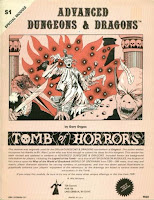 |
| Original cover of ToH |
Yup, it's Tomb of Horrors. This module is the trap module. And today, we are going to start talking about the trap tropes within. Love this module or hate it, ToH has had a profound effect on how traps are viewed and used in D&D. I am putting SPOILER ALERT up now. If you have not played this module and intend to, stop reading. I plan on a few posts on this subject, as ToH is a dense module with a lot of subject matter. Today we will only be covering the entrance hallway superficially. I hope that the reads ask questions and tell me what to elaborate on.
Ignoring the entrance "puzzle" (random choice, unless you are overly cautious or have disposable minions), the first traps an adventuring party comes to are pit traps. Gygax put several pits in the entrance hallway, none of which are in a straight line. (And he uses them to affect 3 out of the 4 uses we outlined previously.)
The next trap is probably the most famous in D&D. The "Face of the Great Green Devil" has confounded players for over 40 years. Without boxed text the details given about the encounter vary wildly. Three clues are emboldened in the text: "Dead, Evil, Magic." These clues should be enough to deter people from jumping in. People grouse about this trap, but if run properly it stands as a good example of an unique trap.
Moving to the immediate left of the Devil Face, we find the weakest of the traps within ToH, the Arch of Mist. It can separate parties (permanently) and does not facilitate fun. If it were modified so that all characters ended near each other (maybe bars separate them or they were 40 feet apart on different ledges) that would lead to interesting encounters. As it stands, this trap has a chance of limiting fun because the party has their time split.
We are still in the entrance hallway, and three different kinds traps already confound. Over the next few weeks, I plan to delve further into the module and discuss if the traps work and why.
See you in the dungeon halls.




